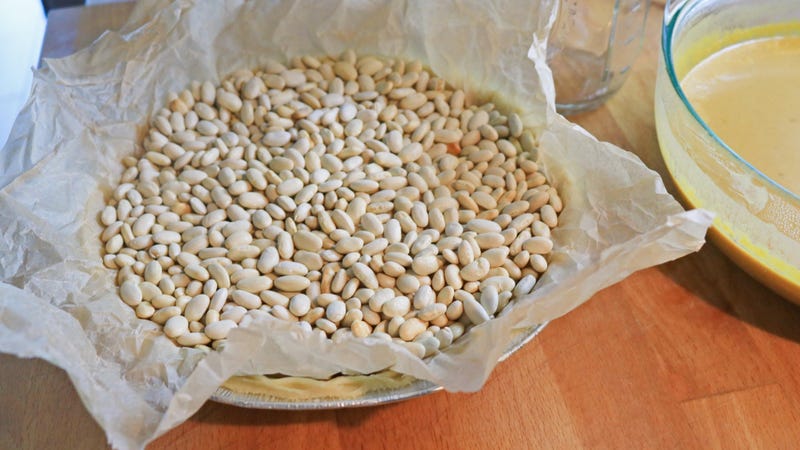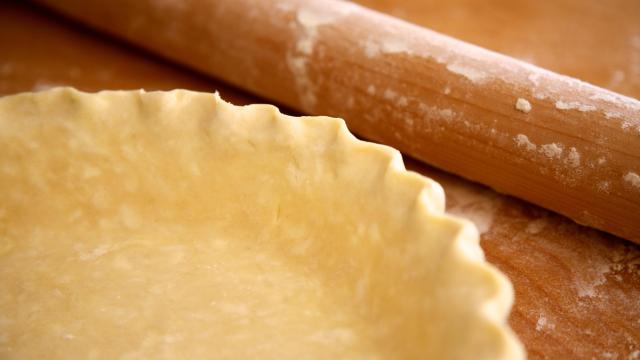Baking a pie or tart is theoretically simple—filling goes in the crust, bake, and eat. But the devil is in the details, as they say, and one part of the fine print is blind baking. In order to prevent a gummy, soggy crust from plaguing your pie’s undercarriage, you’ll need to master this technique. Luckily, it’s pretty easy. Don’t let doughy pies mar your cottagecore lifestyle any longer: Follow these steps to blind bake your pie crust.
What is blind baking?
Blind baking is baking the crust before you fill it. You should do this with store bought or homemade pie dough, with most single-crust pies (like pumpkin or coconut custard), and absolutely with no-bake pie fillings. Again, it sounds easy, but you can’t just chuck the pie dish in the oven without a plan. Pie crusts are full of saturated fat, and are something of a gluten network from all the mixing and rolling. Once the crust hits the heat of the oven, it’ll shrink, slide down the sides, and puff in the center. You need something to keep it in shape until it sets and can stand on its own. That’s where pie weights come in.
Pie weights are any object that is heat-safe, food-safe, heavy enough to weigh down the crust’s desire to move, and their shape can naturally adjust to fill the shape of the pie crust. Ceramic pie weights are little balls that can do the trick, and they’re infinitely reusable. Unfortunately, you need enough of them to fill the pie crust up to the lip, and usually they’re sold in small amounts. You can buy them online or in a kitchen supply store, but they can be costly and potentially hard to find.
For the sometimes-baker, those of us who just don’t feel like dropping $US15 on pie weights, and folks in a pie pinch, you have cheaper options that might just be in your pantry already: Try dry beans, rice, or sugar.
How to blind bake a crust
1. Chill the raw crust
You can blind bake a pie crust whether you’ve made it from scratch or grabbed it from the freezer section of the grocery store. First, if you’re rolling out your own crust, fit it into a pie plate and trim it. Crimp the edge now, because you won’t get a chance to do it after blind baking. Pop it in the fridge or freezer to firm up the fats—this takes about 15 minutes. Starting cold means the saturated fats are solid, and this makes it easier to fill with pie weights without poking a hole through your crust. Preheat your oven to 400°F while you’re “weight-ing.” (It’s been a while since I’ve made any culinary puns. Give me this.)
2. Line the crust and weigh it down

If you’re using a frozen crust you can start at this step. Take the cold crust out of the fridge or freezer. Line the crust with a non-stick, heat-safe liner. I prefer parchment paper, but you can use one very large coffee filter or a few shingled coffee filters (keep in mind it’s hard to take out the weights with that one.) Some folks like aluminum foil, but I’m not a fan. It likes to keep its own wrinkles when you press it into the crust, and those points often dig in during baking. Furthermore, I’ve had pie dough stick to aluminum foil after blind baking, and that’s just unacceptable.
If you’re using parchment paper, tear off a piece that’s about four inches longer than the diameter of the pie dish and crumple it up into a small ball. Then un-crumpled it. The tiny bends and folds will allow the paper to conform to the curves of the pie shell so it fits snug instead of poking into the pastry. Fill the liner with your weights of choice. Make sure you have enough to fill the pie shell all the way up to the top. This prevents any shrinking or sagging.
3. Blind bake it
Bake the pie crust for 20-30 minutes in the 400°F oven, or until you see the exposed edges are beginning to brown. If you can’t see, just lift the edge of the parchment a little to check how it’s going. Carefully remove the pie and lift the edges of the liner with the weights inside. The crust should be lightly browned along the top edge, set, and dry along the sides and bottom. If the center looks greasy or if it’s doughy when you press it, the crust needs more time. The timing will depend on the type of weights you used and your pie crust’s thickness. If needed, lift the liner and pie weights back into the crust. Return the pie shell to the oven and check again in five to 10 minutes.

Once the crust is sufficiently blind baked, take out the weights and liner. Depending on whether your pie has a no-bake filling or not, you can further bake the crust to brown the interior. This will take five to 10 minutes of additional baking. Be sure to keep a close eye on it. Cool the crust on a wire rack, and fill it with pie stuff, silly. If you like to plan ahead, you can wrap the crust and keep it stored in the fridge, or at room temperature, for a couple days. Or really plan ahead and freeze it for up to six months.

Leave a Reply
You must be logged in to post a comment.